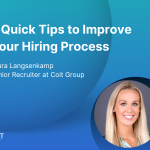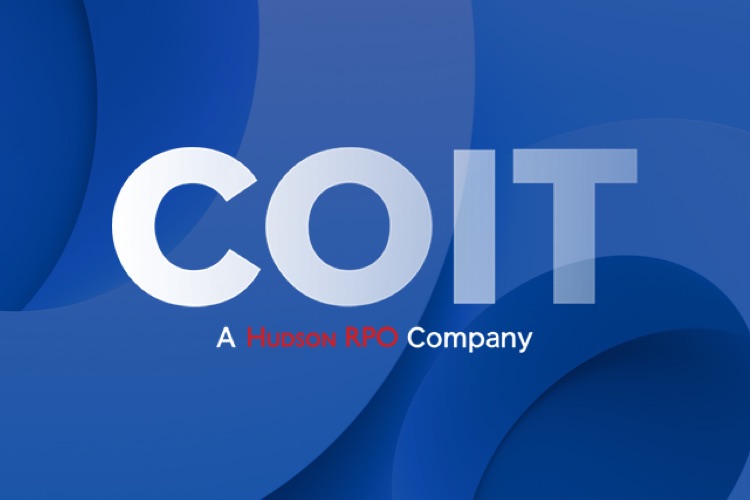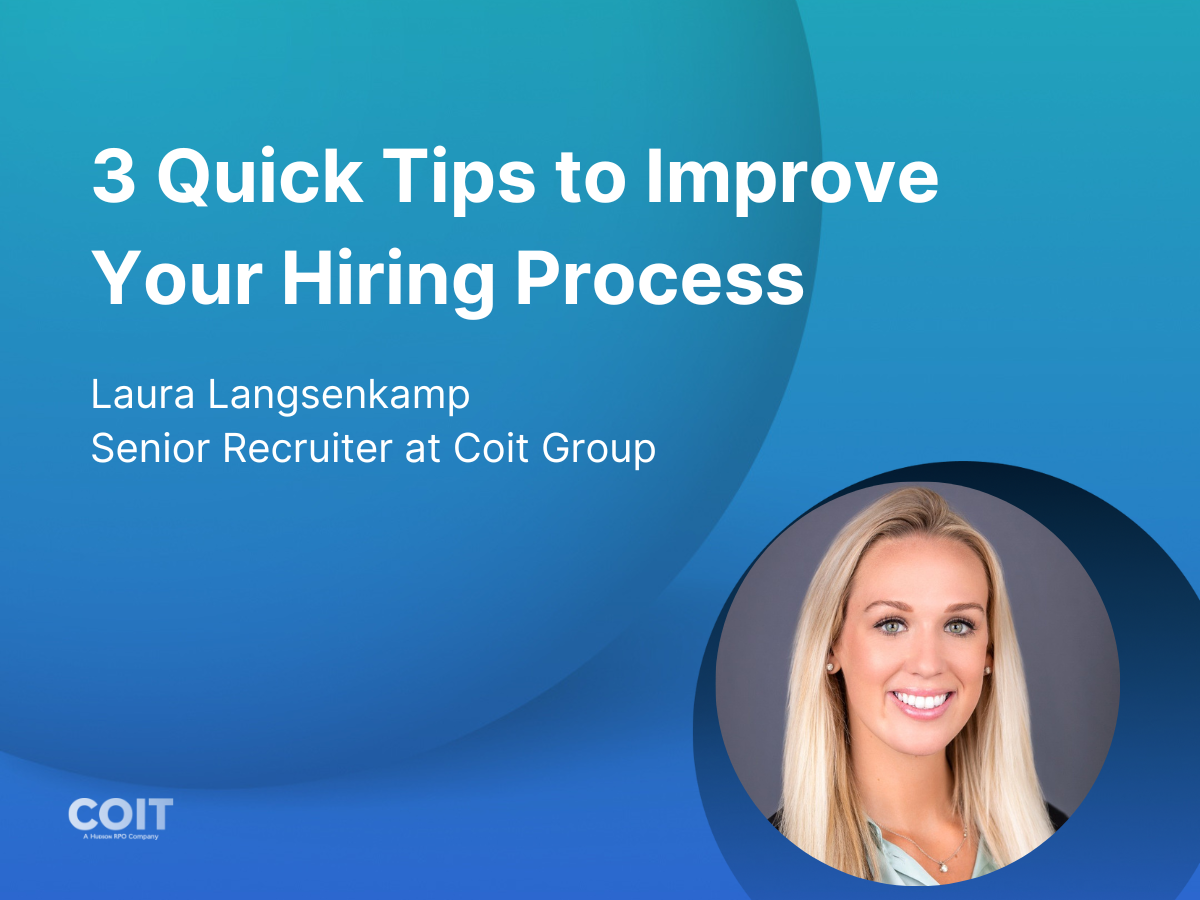This post was written by Una Karanovic, Director, Operations and Recruitment at Coit Group – A Hudson RPO Company
According to conversations I’ve had with my network, a lot of people are projecting that the layoffs will subside in 2024 and hiring will start coming back. It might not come roaring back like it did in the pandemic when companies were flushed with cash, but it will come back. And there will be a sizeable number of roles that need to be filled quickly.
Rapid response hiring is no joke. It’s a strategy that’s becoming increasingly vital for companies navigating the unpredictable tides of the tech industry. So leading into 2024, I wanted to shed light on the nuances and effectiveness of this approach.
Defining Rapid Response
Rapid response hiring is a method that quickly mobilizes resources to meet sudden and large-scale hiring needs, a scenario many companies may face as they backfill roles that were lost over the last 18 months. This approach is particularly relevant in the tech industry, where the pace of change and growth can be dizzyingly fast.
“Quick volume hiring is crucial as the economy goes back to where it was in 2022 and 2023. A lot of companies are probably not going to be ready for the amount of hiring they’re going to have to do.”
Una Karanovic
The essence of rapid response hiring lies in its ability to adapt swiftly to the market’s demands. As companies rebound or expand, they often find themselves in a position where their existing recruitment infrastructure is inadequate to handle the volume and speed required for effective talent acquisition.
This is why the flexibility of an RPO solution, like Coit Group, has become so valuable. With a team of experienced recruiters who are well-versed in the client’s environment and requirements, RPOs can quickly scale up their efforts to meet the hiring surge.
Filling Roles Fast? Easier Said Than Done
Traditional recruitment models, which may not focus on proactive headhunting, often fall short in such scenarios. Rapid response hiring, therefore, is not just about filling positions quickly; it’s about doing so with a strategy that ensures the quality of hires and aligns with the company’s long-term goals.
In today’s competitive job market, where the best candidates are often off the market within days, the ability to rapidly engage and attract top talent is more crucial than ever. This is particularly true in the tech sector, where the right talent can significantly impact a company’s growth and innovation trajectory.
Challenges in Traditional Recruitment
In the realm of recruitment, traditional teams often face significant challenges, particularly when it comes to high-volume hiring. Una points out, “A lot of recruitment teams are not set up because I feel like a lot of recruiters don’t do headhunting.”
In traditional recruitment strategies, it’s easy to fall into more on reactive hiring – waiting for candidates to apply – rather than actively seeking out top talent. But this can lead to significant delays, often felt when the quality of incoming candidates isn’t up to par with the needs of the team, particularly when filling roles that require niche or hard-to-find talent.
Sure, there are many candidates available on the market right now. But they might not necessarily be the right type of candidate. This mismatch can lead to a prolonged hiring process, as recruiters sift through a large volume of applicants to find the few who truly fit the role’s requirements.
And don’t forget that traditional in-house recruiting teams tend to max out their bandwidth when rapid hiring needs come up. It doesn’t make sense to bring on additional full-time recruiters for a short time, so the existing team must bear the extra burden, and that can lead to less-than-optimal hires.
The Power of Headhunting in Rapid Response
But the real secret to rapid response hiring goes beyond additional staffing. It’s finding recruiters that headhunt.
Headhunting is a proactive approach targeting the right candidates who can drive change and contribute significantly to an organization’s success. Top A-player candidates that you want on your team, strategic people…chances are they’re not looking to leave their positions. This means recruiters must reach out to passive candidates who are not actively seeking new opportunities but are the perfect fit for the role.
How does this impact rapid hiring? It addresses speed AND quality. Traditional methods of waiting for applicants can lead to a flood of candidates, but not necessarily the right ones. Headhunting, on the other hand, involves a more targeted search, ensuring that the candidates approached are highly relevant and of high caliber.
“I have always been an advocate, if you want the best top-tier players, top-caliber candidates, you will have to go out and headhunt these people out of their jobs.“
Una Karanovic
This significantly speeds up the recruitment process too. By focusing on candidates who are most likely to succeed in the role, recruiters can reduce the time spent sifting through unsuitable applicants. And every recruiter will tell you, that takes a lot of time.
Case Studies: TikTok and Instacart
Coit Group recruiters thrive in rapid response hiring, and we have the case studies to prove it. Two notable examples that come to mind are TikTok and Instacart.
At TikTok, the challenge was immense. The platform’s explosive growth required hiring many site reliability engineers, a task that proved to be daunting since it was such a specialized role. For TikTok alone, we had 30 recruiters all working on California roles, competing against the internal recruitment team. There was intense competition and urgency in sourcing top talent in a highly competitive market. The solution? Headhunting. Job postings did not work… You had to submit a certain number of candidates, and the only way we got it done? Headhunting.
Instacart presented a different yet equally challenging scenario. The need was broader and required finding unique candidates for various roles, but they were hyper-focused on finding individuals with out-of-the-box thinking and diverse backgrounds.
In the early days, Instacart was very selective, turning down 90% of the candidates we submitted. Their high level of selectivity required a more nuanced approach to headhunting. They were looking for people with unconventional backgrounds, people who could show they would think outside the box, which perfectly aligned with Instacart’s unique needs. Waiting for applicants to come through the door wasn’t going to cut it, and headhunting became the only way to source the right people. I even ended up hiring an analyst from a weather channel because her way of thinking was just so different. I wouldn’t have found her through a resume.
In both scenarios, the ability to quickly adapt and implement targeted headhunting strategies was key to achieving successful, rapid hiring outcomes.
Advice for Organizations Preparing for Rapid Response Hiring
If companies recognize that rapid hiring needs are coming and hope to bolster their internal recruitment capabilities, here are a few suggestions.
Know how your recruiters engage with the market. Especially for critical and urgent roles, you’ll need recruiters who go out into the market and find candidates. If your recruiters are willing to headhunt, then you’re odds of success are high.
Still, the reality is that a single recruiter, even if they are an elite head hunter, can only fill so many roles. It’s why an RPO partnership is such a great solution. Recruiters in RPO solutions are dedicated to your account, branded as your own, and become a part of your team. Find an RPO that has a good history of both filling roles quickly AND bringing in high-quality clients. To make sure this is the case, conduct thorough reference checks with the RPO’s past clients to gauge their effectiveness and efficiency in similar scenarios.
If your organization is looking to bring on additional headcount, Coit’s team of recruiters will be a great fit. Shoot me a message on LinkedIn and I’m more than happy to talk through your hiring plan and lend some suggestions!
Newsletter
Blog Categories
Recent Posts

[Tech x Talent Dashboard] It’s time to change DEI metrics and tactics

3 Quick Tips to Improve Your Hiring Process

Beyond the Checkbox: DEI in 2024 and Beyond

The Unexpected Secret to Effective Rapid Response Hiring




